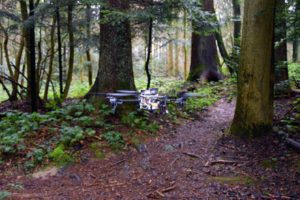
Their story had a happy ending – after spending what was probably the longest night of their life in the wild, Elizabeth and Jennifer were rescued. However, for every rescue story, there are just as many tragedies to report as lost hikers succumb to the elements and other dangers by the hundreds each year.
But what if rescuers could deploy an aerial eye-in-the-sky that could not only search autonomously, but could also recognize and follow forest paths and trails?
That’s the vision of researchers with the University of Zurich, the Università della Svizzera italiana, and the University of Applied Sciences and Arts of Southern Switzerland. The team recently developed a software solution that allows drones to conduct autonomous searches as well detect and follow forest or mountain paths used by hikers.
“While drones flying at high altitudes are already being used commercially, drones cannot yet fly autonomously in complex environments, such as dense forests,” Zurich Professor Davide Scaramuzza said in a press release.
“In these environments, any little error may result in a crash, and robots need a powerful brain in order to make sense of the complex world around them.”
Equipped with the new software, the team’s UAVs mate powerful cameras with cutting-edge sensor arrays that rely on artificial-intelligence algorithms to interpret imagery and recognize human-created trails and paths.
“Interpreting an image taken in a complex environment such as a forest is incredibly difficult for a computer,” Dr. Alessandro Giusti from the Dalle Molle Institute for Artificial Intelligence said. “Sometimes even humans struggle to find the trail.”
While the concept of drone-guided search teams may be welcome news to hikers, climbers and kayakers worldwide, the team cautions that they are only at the starting point in research.
“Many technological issues must be overcome before the most ambitious applications can become a reality,” Professor Luca Maria Gambardella, director of the Dalle Molle Institute for Artificial Intelligence, added.
“But small flying robots are incredibly versatile, and the field is advancing at an unseen pace. One day robots will work side by side with human rescuers to make our lives safer.”
Jason is a longstanding contributor to DroneLife with an avid interest in all things tech. He focuses on anti-drone technologies and the public safety sector; police, fire, and search and rescue.
Beginning his career as a journalist in 1996, Jason has since written and edited thousands of engaging news articles, blog posts, press releases and online content.
Email Jason
TWITTER:@JasonPReagan
Subscribe to DroneLife here.